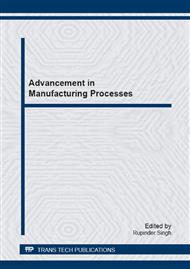[1]
E.O. Ezugwu, and Z.M. Wang, Titanium alloys and their machinability-A review. Journal of Materials Processing Technology 68 1997 262–274.
DOI: 10.1016/s0924-0136(96)00030-1
Google Scholar
[2]
K.H. Ho and S.T. Newman, State of the art electrical discharge machining. International Journal of Machine Tools & Manufacture 43 2003 1287-1300.
DOI: 10.1016/s0890-6955(03)00162-7
Google Scholar
[3]
H. Ahmet and C. Ulas, Electric discharge machining of titanium alloy (Ti-6Al-4V), Applied Surface Science 253 2007 9007-9016.
DOI: 10.1016/j.apsusc.2007.05.031
Google Scholar
[4]
S.L. Chen, B.H. Yan and F.Y. Huang, Influence of kerosene and distilled water as dielectrics on the electric discharge machining characteristics of Ti–6Al–4V. Journal of Materials Processing Technology 87 1999 107-111.
DOI: 10.1016/s0924-0136(98)00340-9
Google Scholar
[5]
C.L. Yan, H.Y. Biing and S.C. Yong, Machining characteristics of titanium alloy (Ti-6Al-4V) using a combination process of EDM with USM. Journal of Materials Processing Technology 104 2000 171-177.
DOI: 10.1016/s0924-0136(00)00539-2
Google Scholar
[6]
B.H. Yan, H.C. Tsai and F.Y. Huang, The effect in EDM of a dielectric of a urea solution in water on modifying the surface of titanium. International Journal of Machine Tools & Manufacture 45 2005 194-200.
DOI: 10.1016/j.ijmachtools.2004.07.006
Google Scholar
[7]
J.Y. Kao, C.C. Tsao, S.S. Wang and C.Y. Hsu, Optimization of the EDM parameters on Ti-6Al-4V with multiple quality characteristics. International Journal of Advanced Manufacturing Technology 47 2010 395-402.
DOI: 10.1007/s00170-009-2208-3
Google Scholar
[8]
B. Jabbaripour, M.H. Sadeghi, S. Faridvand and M.R. Shabgard, Investigating the Effects of EDM Parameters on Surface Integrity, MRR and TWR in Machining of Ti-6Al-4V. Machining Science and Technology: An International Journal 16 2012 419-444.
DOI: 10.1080/10910344.2012.698971
Google Scholar
[9]
C. Can, D. Tayfun and C.K. Gokhan, A geometrical approach for reduction of tool shape degeneration in electric discharge machining (EDM). Machining Science and Technology: An International Journal 16 2012 445–458.
DOI: 10.1080/10910344.2012.699369
Google Scholar
[10]
A. Bhattacharya, A. Batish and N. Kumar, Surface characterization and material migration during surface modification of die steels with silicon, graphite and tungsten powder in EDM process. Journal of Mechanical Science and Technology 27(1) 2013 133-140.
DOI: 10.1007/s12206-012-0883-8
Google Scholar
[11]
M.A. Norliana, G. Dariu and M.F. B Solomon, A review on current research trends in electrical discharge machining (EDM). International Journal of Machine Tools & Manufacture 2007, 47, 1214–1228.
DOI: 10.1016/j.ijmachtools.2006.08.026
Google Scholar
[12]
S. Abdulkareem, Suleiman, A.A. Khan and M. Mohamed, Reducing electrode wear ratio using cryogenic cooling during electrical discharge machining. International Journal of Advanced Manufuring Technology 45 2009 1146–1151.
DOI: 10.1007/s00170-009-2060-5
Google Scholar
[13]
S.S. Gill and J. Singh, Effect of deep cryogenic treatment on machinability of titanium alloy (ti-6246) in electric discharge drilling. Materials and Manufacturing Processes 25 2010 378–385.
DOI: 10.1080/10426910903179914
Google Scholar
[14]
A. Kumar, S. Maheshwari and C. Sharma, Effect of cryogenically treated electrode during aedm of nickel based super alloy 718 for surface quality improvement. Advanced Materials Research 410 2012 236-239.
DOI: 10.4028/www.scientific.net/amr.410.236
Google Scholar
[15]
V. Srivastava and P.M. Pandey, Effect of process parameters on the performances of EDM process with ultrasonic assisted cryogenically cooled electrode. Journal of Manufacturing Processes 14(3) 2012 393-402.
DOI: 10.1016/j.jmapro.2012.05.001
Google Scholar
[16]
J.M. Jafferson and P. Hariharan, Machining performance of cryogenically treated electrodes in microelectric discharge machining: a comparative experimental study. Materials and Manufacturing Processes 28 2013 397–402.
DOI: 10.1080/10426914.2013.763955
Google Scholar
[17]
P.J. Ross, Taguchi techniques for quality engineering, McGraw hill, New York, 2nd ed., (1996).
Google Scholar
[18]
Y. Yakup and N. Muammer (2008) A review of cryogenic cooling in machining processes. International Journal of Machine Tools & Manufacture 48 2008 947-964.
DOI: 10.1016/j.ijmachtools.2008.01.008
Google Scholar


